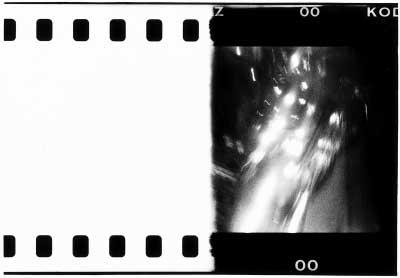9 - 31. 01. 1998

Emmett Williams, from the series +/-. Foto © Elżbieta Janicka
Maria Janion, from the series +/-. Foto © Elżbieta Janicka
I, PHOTOGRAPHY
The Visible
- what can be seen; the sphere of reality perceived by the perceiver as its visual manifestation/the seen;
- the limits of the visible conditioned by perceptive abilities and limitations of the perceiver
The Seen
- one of the aspects of reality, dependent in its shape on the features of perception confronted with reality;
- equal validity of various forms of perception/the seen
A Photographic Image
resultant of
- reality and perceptive qualities of two perceivers:
- the photographer with his psycho-physiological complexity of perception
- and photography with its technical parameters, manifesting its independence from human vision; (when shaping the image, the medium/tool marks its presence almost as if it were some another "I", a second - beside man - perceiveing subject).
Reality
a "score", of which the photographic image revealsthan human eyes;
- Less
- more
- in a different manner
- something else
- in spite of the differences there is a certain sphere of the visible and the shape of the seen which is common for photography and the photographer, hence the possibility of analysis and comparison of their two ways of seeing.
Elżbieta Janicka
from the series: I, PHOTOGRAPHY. Foto © Elżbieta Janicka
from the series: I, PHOTOGRAPHY. Foto © Elżbieta Janicka
"Photography" - Photography
Among many photographic propositions of today I became interested in the theoretical and practical work of Elżbieta Janicka, a student of the College of Photography at the Lodz Film School. Her texts on photography are intriguing due to their inquisitiveness and rational message. Such an ardent approach to the problems in question lets us suppose that the author's work is only the beginning, only the first step on the road to discovering what photography is and how it functions. Elżbieta Janicka realizes that it requires the rejection of numerous superstitions and taboos, growing around the medium and its productions. She is trying to find the essence of photography in a complicated postmodernist world, answering to the challenge made in the past by such theoreticians as Karol Irzykowski, Maya Deren, Andre Bazin, Roland Barthes or Christian Metz, among others. Thanks to the authors mentioned above at the end of the 1960s we were able to conclude that photography was born as BLURRED MEANING, but one that was undobtedly a physical image of physico-chemical reactions. Elżbieta Janicka needs those historical relations to conduct, for example, a practical analysis of photographic portraits as images clearly prone to psychological overinterpretations. The analysis of the works by the most prominent masters of the photographic portrait - of their preliminary propositions and the results achieved - reveals that photography is "a different element", governed by its own laws highly independent of human behaviour. From this point of view a photographic camera turns out to be "an antropometric instrument" that indifferently copies human faces. This EXTERNAL IMAGE still remains most significant of all, since it may be used to identify a photographic image with empirical reality. The author of texts on photography takes photographs of faces, objects, fragments of reality. I know that she was trying to create photographic images which were to be equivalents of the physical world - the world photography itself is a part of. Janicka's work, however, also raises the question of perception, of individual and group attitudes towards an image. The image in itself is devoid of all emotional qualities. It is only during the time of perception that feelings and interpretations are born which make us actually look at ourselves while looking at a photograph. This exhibition is going to be an expression of the author's beliefs on the subject. In relation with the photographs the public will have an opportunity to react to a clear-cut problem, beginning "an interpretative journey of one's consciousness and subconsciousness".
Józef Robakowski (1997)
Translation by Maciej Świerkocki
from the series: f2. Foto © Elżbieta Janicka
from the series: f2. Foto © Elżbieta Janicka
Copyright ©1998 Elżbieta Janicka, Józef Robakowski, Maciej Świerkocki, Galeria FF ŁDK





